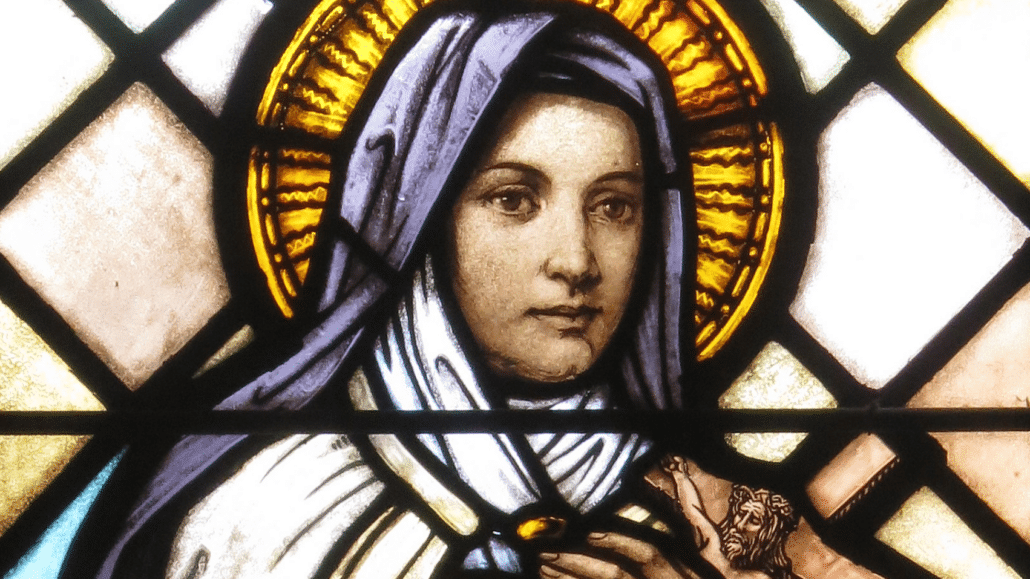A few years ago, Paraclete Press, a lovely, small press out of Cape Cod, Massachusetts, approached me with the idea of writing a book about “walking” with a saint for a year. Not a biography or a hagiography, but a sort of lived reflection on the saint’s works, thoughts, prayer, and path.
So I thought for a bit and chose Thérèse of Lisieux (1873-1897) because, let’s face it, there is something irresistible about a beautiful, young French girl who wanted to be the bride of Christ so badly that, at the age of 14, she traveled to Rome, knelt at the feet of Pope Leo XIII, and begged for permission to enter the cold, cloistered convent at Carmel.
This was the woman who spent the rest of her short life in obscurity, but on spiritual fire. She was the woman who, after coughing up blood at the beginning of Lent one year, was thrilled to know that more suffering—and heaven—lay ahead.
She was the woman who, with gangrened intestines and no pain medication, once cried out: “I love Him!,” she, who first dashed off a spiritual biography in a cheap notebook that came to be known as The Story of a Soul, which has gone on to sell millions of copies.
Thérèse was sickly as an infant and had to be farmed out to a wet nurse from whom she was later separated. Her mother died of breast cancer when Thérèse was 4. Her two beloved older sisters left fairly soon after for the cloistered convent at Carmel. Thérèse herself entered the same convent at the age of 15, lived a hidden, outwardly unremarkable life there, and died at the tender age of 24 from tuberculosis.
Thérèse might have remained entirely unknown had she not left behind the notes for what became The Story of a Soul, which her sister Pauline edited and published. She was canonized as a saint a mere 28 years later. In 1997, she was named a Doctor of the Church (one of only three women upon whom the honor has been bestowed). Her “little way” continues to inspire, challenge, invite, and confound. And people, including me, continue to write books about her.
A New Surrender
This book I was writing did not have to be long: 35,000 words. I was not getting a huge advance, which was fine with me. To receive a royalty check, just once before I died, would represent a major triumph.
So I got down to work and immersed myself in St. Thérèse. I read some of the zillions of other books that have been written about her (thinking that mine, of course, would be different). I lived another year of my life writing and revising, and went off to Taos, New Mexico, early in 2010 on a three-month residency and finished the book. I waited months for the contract to be signed. I sent off the manuscript and waited months to get notes.
And when the notes came back, it turned out there was too much of me in there and not enough of St. Thérèse. Naturally, I was mortified. What had I been thinking? Who on God’s green earth would want to read anything about me when the subject was Thérèse? So I cut all the parts about me—which was about half the book—and rewrote the first three chapters. I sent them off, at which point they said there was not enough about me and they wanted me to put some back in.
The point being that, halfway through the book, I was given to see that this was not a mere job. The book was meant to be a way deeper “walk” with St. Thérèse than I’d envisioned. The book was meant to be a surrender on a whole new level.
Because, while writing means everything to me, so does getting noticed. That we don’t get to say or see where or how our work bears fruit, in fact, has to be one of the most difficult parts of the spiritual path.
So finding my voice with this St. Thérèse book was a challenge. I had to find a way to incorporate the right kind of “me.” I needed to be honest enough to say that what I’d really been struggling with during my year with her was that, to be a single, aging woman without significant means does not exactly put you at the top of the human heap. That it is all very well to talk about “the scandal of the cross,” but to experience it is a very different thing.
That’s exactly where Thérèse came in.
A Little Miracle
As a toddler, Thérèse was sunny, winning, confident. But after her mother died, she turned fretful and even neurotic. She suffered from scruples. She tried to over-bond. She cried and then she apologized for crying. Then she made matters worse by apologizing for apologizing.
But on Christmas Eve of 1886, when Therese was 13, she underwent what she called her second conversion. “God would have to work a little miracle to make me grow up,” she recognized, “and this miracle He performed on that unforgettable Christmas day.”
Here’s how it happened: the custom at the time was for the children of the house to leave their empty shoes by the fire for the parents to fill with Christmas candy. Thérèse, the youngest, was the last to keep up the custom.
Upon returning from Mass that night, her usually kind and pious father, uncharacteristically cranky, passed the shoes and remarked, “Well, thank heaven, this will be the last year. Thérèse is really getting too old for this.”
Thérèse overheard him. Ordinarily she would have burst into tears and made a scene, devastated at the thought of having displeased her father. Choking back sobs, she began running upstairs to her room. But at the moment, something changed. Thérèse gathered herself, allowed herself to experience—but not be overwhelmed by—the feelings of hurt, and marched downstairs like an adult to open her presents with gratitude, good cheer, and joy.
The episode marked a turning point. In The Story of a Soul, Thérèse wrote: “On that night when He made Himself weak and suffering out of love for me, He made me strong and courageous. He put his armor on me, and since that blessed night I was never defeated in combat.”
She also wrote: “On that night of light, the third period of my life began, the most beautiful of them all, the most filled with graces from heaven. I felt a great desire to work for the conversion of sinners, a desire that I had never felt so strongly . . . . In a word, I felt charity enter into my heart, the need to forget myself in order to please others, and ever afterward I was happy!”
Thérèse turned a corner. She overcame her childhood fear of abandonment and rejection. After that, she never had to insist on her own way because, in a sense, she always got her own way, which was to love and to be loved by God in total freedom.
Story of My Soul
Once, I had an epiphany. I realized that I’d been led to St. Thérèse in order to experience a similar conversion: to be shown that the point wasn’t whether my book sold or how successful my work was. The point is that our suffering always bears fruit; that our wounds are often the richest and most useful things about us; that our ongoing conversion is a mystery and blessing. It is not ever going to be given to us on this side to understand.
Maybe our true gift is just to figure out who we are and be that. Maybe my personally painful habit of wearing my heart on my sleeve, if I could channel it the right way, was a gift.
Mother Marie de Gonzague, the superior at Carmel, ended up writing of Thérèse: “Tall and strong, with the air of a child, with a tone of voice and an expression that hide in her the wisdom, perfection and perspicacity of a 50-year-old . . . a little ‘untouchable saint,’ to whom you would give the Good God without confession, but whose cap is full of mischief to play on whomever she wants.
“A mystic, a comic, she is everything. She can make you weep with devotion and just as easily faint with laughing during recreation.”
May I take a page from that book as I continue to write my own.








